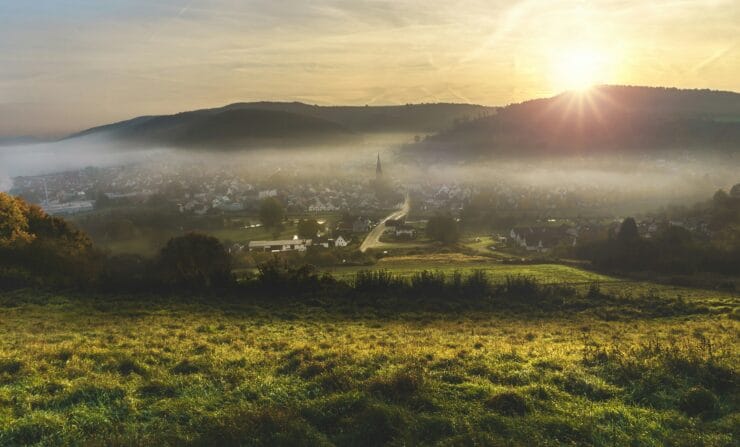Learn about Sunshine benefits…
It's spring and time to get out into the sunshine, right? Not according to some who say we should strictly limit our time in the sun, or that we should slather on plenty of sunscreen first to avoid wrinkles and skin cancer.
But how natural is that?
Sunscreen, most full of nasty chemicals, vs. sunshine, which helps our bodies make plenty of vitamin D…? Which will you pick?! (Find safer sunscreens here.)
Don't be afraid of the sun!
A Common Sense Article from Harvard
In recent years, the advice to totally avoid sun exposure hasn't set right with me. Yes, I know that some say there have been changes in the earth's ozone, so the sun can be more dangerous than in years past. But how could something as natural as the sun be unhealthy as many would have us believe? This article from Harvard Medical School on sunshine takes a more believable middle road on the issue:
- “Several studies have suggested that suddenly getting a lot of sun is more dangerous than steady exposure over time.”
- “There is a well-documented relationship between low vitamin D levels and poor bone health. Now links have been made to everything from multiple sclerosis to prostate cancer. “Linking” low vitamin D with these diseases doesn’t prove cause-and-effect, but it suggests that possibility. Getting some sun may also shake off the wintertime blues: Research suggests that light hitting your skin, not just your eyes, helps reverse seasonal affective disorder (SAD). Moreover, being outside gets us golfing, gardening, and engaging in other types of physical activity.” (Also read about how taking my cod liver oil is, for me, like an all-natural chill pill!)
- “Nobody wants to get skin cancer, but we’ve gone from sun worship to sun dread. Dr. Stern and others say there is a middle way that includes using a sunscreen with a sun protection factor (SPF) of at least 15 when you’re outside for an extended period and wearing a hat and shirt around midday. So when summer’s here, get outside and enjoy it!”
More on Vitamin D and the many health benefits:
- Prevents/treats depression and the “winter blues”/S.A.D. (Seasonal Affective Disorder)
- U.S. News and World Report: “Almost everyone needs more of the sunshine vitamin” – Vitamin D for bone health, lower diabetes risk, protection against TB, colds and flu
- Decreases multiple sclerosis risk
- Prevents cancer:
- USA Today: “Vitamin D research may have doctors prescribing sunshine” The research of Dr. Edward Giovannucci, a Harvard University professor of medicine and nutrition, suggests that vitamin D might help prevent 30 deaths for each one caused by skin cancer. “I would challenge anyone to find an area or nutrient or any factor that has such consistent anti-cancer benefits as vitamin D,” Giovannucci told the cancer scientists. “The data are really quite remarkable.”
Here's what our family does:
As soon as there's a hint of spring in the air, we're outside as much as possible and our skin slowly builds up a good base. As we go through the summer, we rarely need much sunscreen. I only put it on the kids or I if we're going to be outside without shelter for a long time, especially in the middle of the day, or if we'll be by water, and then only after we get some sun without sunscreen for a while first. (How long depends on how much we've already been in the sun that year.) Sometimes I'll only put it on their cheeks, noses, shoulders and tops of their ears. You have to know your/your kid's skin and just be smart about it.
Be careful!
Use common sense. Be especially careful with kids. If your skin is very fair you may have to use more sunscreen than our family does. (Or if you haven't been in the sun much, and obviously if you're vacationing in a hotter climate.) Remember, the goal is to get some sunshine on your skin for the vitamin D (and probably many other health benefits that only God knows), but NEVER LET YOURSELF BURN!
What about wrinkles?
Most people think wrinkles are from sun damage. This may be partially true, and mostly if your skin has been burned a lot, but there are many other risk factors: age, smoking, stress, genetics, and I've also read that not getting enough healthy fats in your diet plays a HUGE role.
All natural sunscreens?
There are many non-toxic sunscreens on the market that have natural ingredients, so you can avoid the chemicals. Especially if you have very fair skin and/or you are in the sun a lot, don't skimp on this.
Who to believe?
There are conflicting studies (big surprise!), and some sources still say that any sun exposure is dangerous. Do some reading and decide for yourself, but as always, above all, use common sense.
More you might like:
- The best way to get vitamin D in the winter: cod liver oil! (Don't worry, you can take the capsules.)
- Dr. Eades says the same thing, I love him!
- Omega 3's in cod liver oil can prevent sunburn – scroll down about 2/3 on this page to read about that and more on the many benefits of cod liver oil.
- Where is the TRUTH on health & nutrition?
- Need some meatless/vegetarian meal ideas?
- Other main dish ideas (scroll down through them all)
Photo by Sebastian Unrau on Unsplash






Julie says
I have noticed that I have been feeling better the past few days. I attribute that to being able to be outside in the sun.
Kelly the Kitchen Kop says
Shauna,
Thanks for pointing out a major part of the story that I forgot to add!
Kelly
Michigan Mom2three says
Anna, I don’t think your liver spots going away is a coincidence. I, too, had noticed my hands were looking better (skin tone wise), and that my brown spots were not so obvious…. but I didn’t realize until I read your comment WHY! WOW! cool! I, too, have completely changed my saturated fat ratios and consume lots of coconut oil and butter now. Also, with regards to skin cancer, I believe it was in one of the side bars (or perhaps the fats introduction) to Nourishing Traditions that Sally Fallon points out that in areas of the world (mainly tropical), where there is a high saturated fat intake, skin cancer is virtually unknown. It is the correlation of a high intake of UNsaturates combined with sun exposure that sets us up for skin cancer. This explains the mystery of why so many native peoples who live in the tropical and subtropical regions who virtually LIVE in full sun, don’t have skin cancer! I have always wondered that…. if sun exposure is so dangerous, why aren’t those people just dropping of skin cancer? In addition, the tropical peoples who retain their traditional diets have very few “age spots” and very few “wrinkles”…… again the saturated fats provide the protection is what Price surmised. I can certainly look for the reference if anyone would like, I hate posting “I read” with no reference, but I’m 90% sure it was in Nourishing Traditions somewhere (so many sidbars in that book to keep track of!)
Shauna
Kelly the Kitchen Kop says
Anna,
I’m curious – do you take cod liver oil for your vitamin D3?
Thanks for the great comment full of great info!
Kelly
Anna says
Wise words about the sun, Kelly. I’m one of those people who doesn’t tan well; I rust. But I learned the hard way that the sun is more my friend than my enemy, despite what my dermatologist says.
But I learned the hard way that the sun is more my friend than my enemy, despite what my dermatologist says.
I started to get those brown “liver” spots on the back of my hands in my late 20s – back when I was cutting most of the saturated fats out of my diet and increasing my consumption of polyunsaturated oils – also eating too much sugar and starch. After I flip-flopped my SFA-PUFA ratios in my late 30s/early 40s, I noticed I had stopped getting new spots, the smaller ones are gone, and the remaining ones are quite faded (I’m 46 now). Maybe coincidence, but maybe not.
In my 30s, I had a basal cell carcinoma on my nose, near my nostril, which was removed with MOHS surgery and repaired with a small skin graft from my cheek (just in front of my ear). Not fun, the healing process of the graft takes several months, but it was repaired quite well. So I take skin cancer very seriously, especially now living in sunny So California the past 12 years.
After my skin cancer experience, learned I had a 50% chance of having another cancer on my nose within 5 years (not due to recent sun damage, but exposure much earlier in my life – probably when I was trying to tan my teenage Irish-German heritage skin with my Italian-American friends). I carefully avoided the sun during most of the day, used lots of daily sunscreen, covered up with clothes, hats, and chose shady spots. Looking back on it, though, it was like living in a cave.
Without going into too much detail, I now think such extremely reduced sun exposure wasn’t so good for me.
Instead, I now try a more middle of the road approach to the sun. The damage from the past is done and I can’t undo that – so I may still get skin cancers. Avoiding burns and the damage they inflict is very prudent, of course. But I am now much less concerned about the cosmetic issues of sun exposure (wrinkles), because I think too much concern about cosmetic aspects, as well as easily treatable and non-fatal skin cancers is now linked to increased risk of not enough sun exposure for prevention of more important health issues.
Sunlight exposure helps regulate circadian rhythms, sleep patterns, energy patterns, immune response, hormone production, mood/mental health, and overall well-being. There is a fine line between too much and not enough and as you say, the current sun phobia is leaning toward not enough.
I try to get a bit of sun, daily if I can, with as much skin exposure as I can manage (sometimes it is just too cool). I time it for 10-15 minutes per side. I do still cover up my upper chest, neck and face area, because earlier sunburns have permanently reddened those areas (damaged capillaries). This way I get the barest hint of a tan. My mood is better, my energy is better, and my sleep is better.
Like you, I still do use sunscreen (especially on my vulnerable nose and upper chest) if we go to the beach or have a prolonged day in the sun, when covering up with clothing might not be entirely practical. At the same time, I’m also choosing more crew necked t-shirts instead of v-necks, wear a hat sometimes, and otherwise cover up to regulate my exposure instead slathering on the questionable chemicals as my first line of regulation. I just no longer can see a good reason to use a daily sunscreen product all day, everyday. Sunscreens raise more questions than they do answers.
In the winter especially, I now make sure to get enough Vit D3 supplements, because even in So Cal, the winter light spectrum that produces Vit D3 production in the skin is very reduced (a short time around midday) and there is no way I can be getting enough skin exposure even if I were to brave the cool temps and lay out. For instance, even after about 8 mos of taking 2000-4000 iU of Vit D3 most days, when I had my 25 OHD test, my results were only at 44. Makes we wonder how low it was before I started taking Vit D3. My doctor was fine with that result, but I still want to get the level to over 50, and preferably to 60 or more. I am quite reassured, though, that my high supplement level is not overdoing it, and I could even take a higher dose.
Interestingly, a childhood friend of mine was diagnosed with breast cancer last fall. There is a family history of BC, so it wasn’t super surprising (though obviously worrying and upsetting). Her Vit D levels (25 OHD test) was about 15! She’s also very fair (probably avoiding sun exposure), lives in the Pacific Northwest (higher rates of cancer the farther north one goes), and works all day indoors – a recipe for low Vit D3 production. That’s much too low (around 30 is the generally accepted minimum). Hard to know if her Vit D levels were part of her higher risk for cancer (there are other possible factors, too), but the research is largely suggesting it could be a factor. She’s doing fine so far, I’m happy to say.
There’s lots of breaking Vit D3 research info at the non-profit Vitamin D Council. They have a great newsletter and website (easy to find with an online search engine) if you haven’t yet been there.
Glad to see the sunny topic on your sunny blog, Kelly! I think I’ll go outside to eat my eggs for breakfast this morning. The sun is in a perfect spot on the patio, though it is only 56